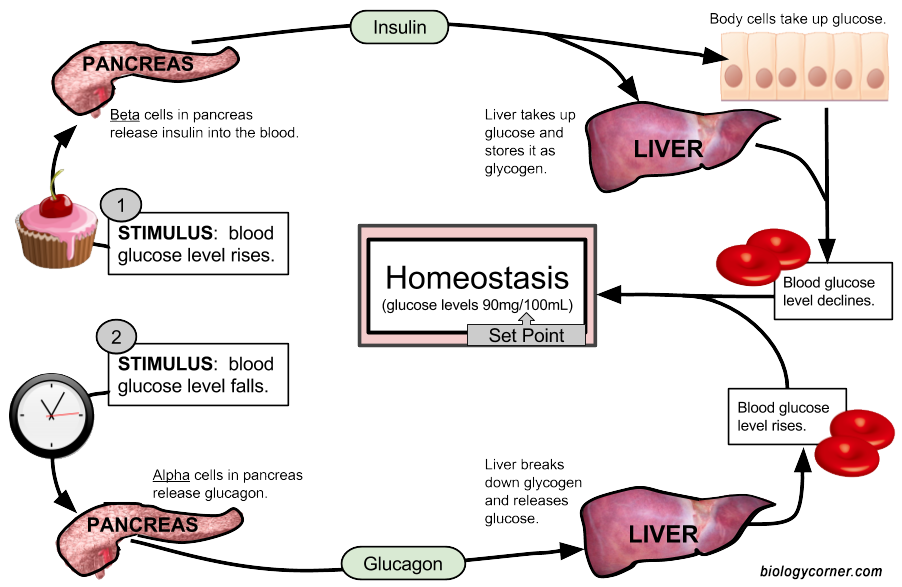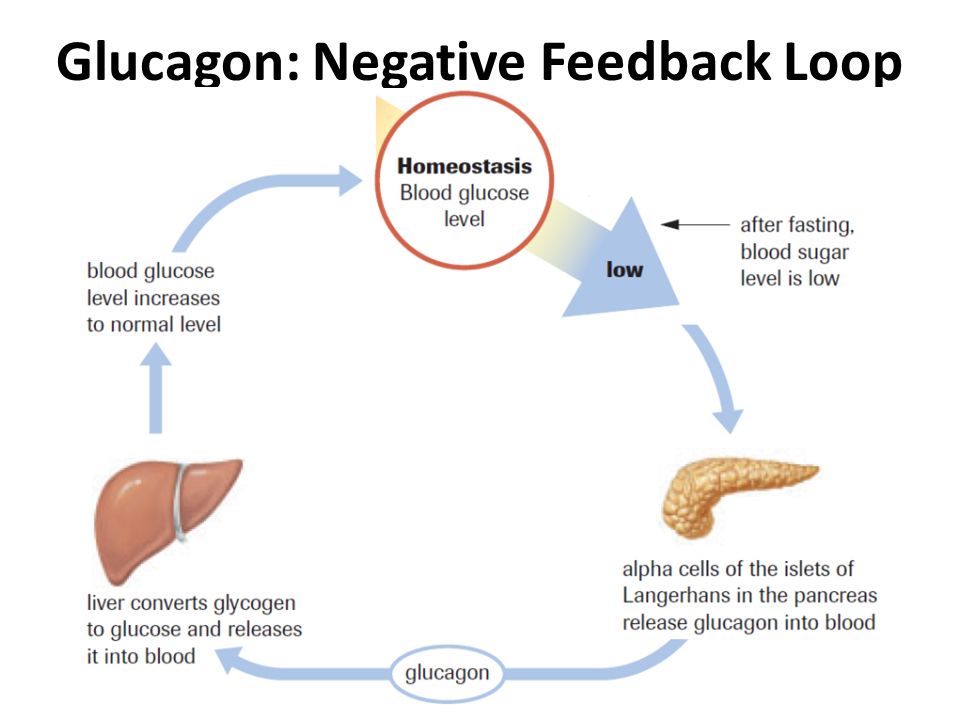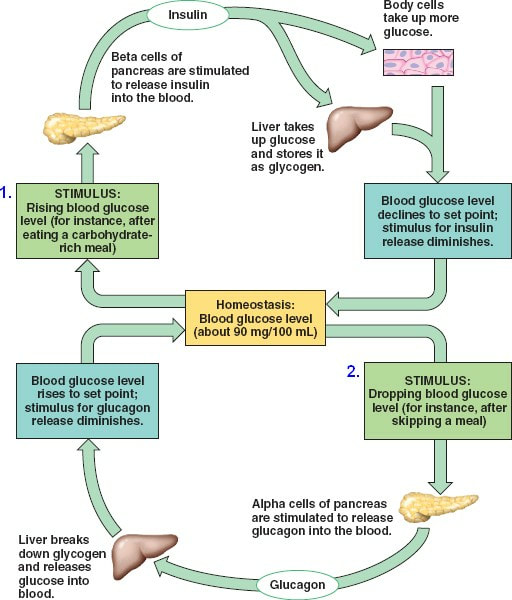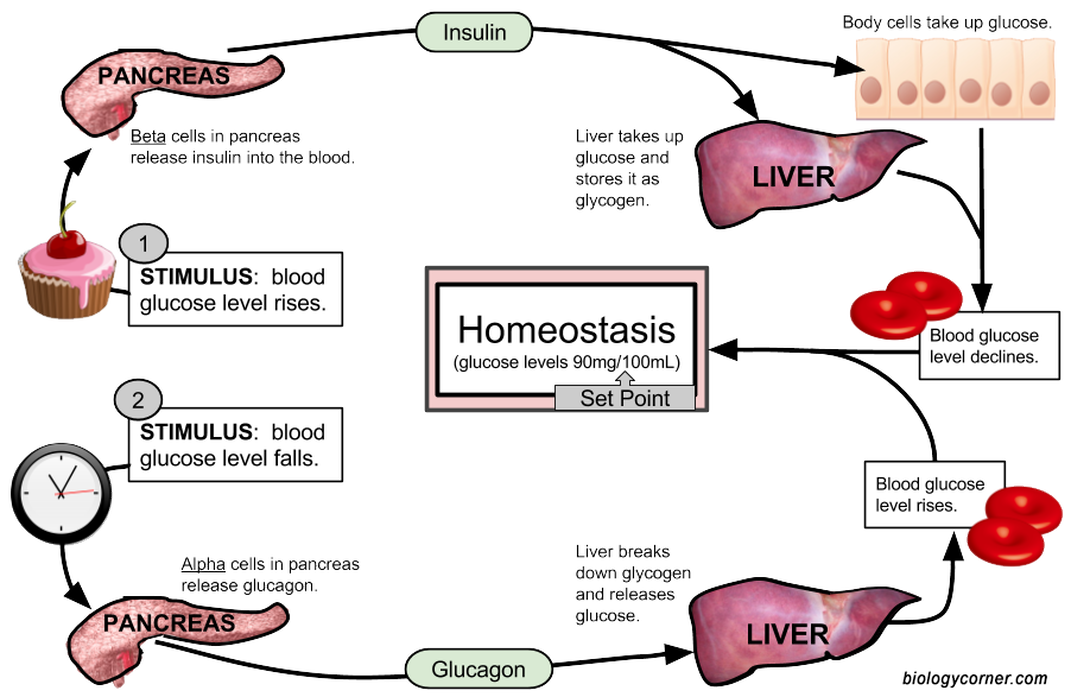LAB EXERCISE: Endocrine, Hyperglycemia, Hypoglycemia, Diabetes

The body uses two systems to communicate with the body:
- the endocrine system
- the nervous system.
- Hormones are chemical signals that are synthesized and secreted by endocrine cells/glands
- Receptors on the cell surface will use second messenger systems to cause a rapid, non-genomic effect.
- Receptors in the cytoplasm and nucleus will influence transcription/translation causing a slower genomic effect.
- If a cell does not contain the receptor that is specific for that hormone, then it will not respond to the hormone .
Steroid hormones
Steroid hormones include corticosteroids and sex hormones. Steroid hormones are derived from cholesterol.
PROPERTIES OF STEROID HORMONES
1) Steroid hormones are hydrophobic so they are able to cross the cell membrane
2) Steroid hormones require a carrier protein to travel through the blood stream
3) Steroid hormones have receptors that are located in the cell's cytoplasm or nucleas causing SLOW ACTIONS.
4) Steroid hormones have a long half-life.
Steroid hormones include corticosteroids and sex hormones. Steroid hormones are derived from cholesterol.
PROPERTIES OF STEROID HORMONES
1) Steroid hormones are hydrophobic so they are able to cross the cell membrane
2) Steroid hormones require a carrier protein to travel through the blood stream
3) Steroid hormones have receptors that are located in the cell's cytoplasm or nucleas causing SLOW ACTIONS.
4) Steroid hormones have a long half-life.
Non-Steroidal Hormones
Non-steroidal hormones include
1) peptide hormones
2) amino acid-derived hormones
PROPERTIES OF NON-STEROIDAL HORMONES
1) Non-Steroidal hormones are hydrophillic so they are soluble in bodily fluids
2) Non-Steroidal hormone receptors are located on the cell's surface so they cause a rapid non-genomic effect
3) Non-Steroidal hormones have a short half-life.
1) Non-Steroidal hormones are hydrophillic so they are soluble in bodily fluids
2) Non-Steroidal hormone receptors are located on the cell's surface so they cause a rapid non-genomic effect
3) Non-Steroidal hormones have a short half-life.
|
|
Peptide hormones
Peptide hormones are synthesized through transcription and translation and are stored by the cell in storage vesicles until the cell receives a signal to secrete the hormone. Most hormones are considered peptide hormones. Amino acid-derived hormones
Amino acid-derived hormones are formed from amino acid precursors. For example, the amino acid tryptopohan is used by the body to make a dopamine, norepinephrine, epinephrine, melatonin and serotonin. The amino acid tyrosine is used to make the thyroid hormones triiodothyronine (T3) and thyroxine (T4) which regulate the metabolism and energy levels of the body. The amino acid glutamic acid is used to make histamines which function as part of the body's immune system. |
These experiments relate to the body's endocrine pathways and demonstrate how hormones help our body maintain homeostasis.
Regulation of Blood Glucose

Insulin is a hormone released by the body in response to high blood glucose levels. When insulin is introduced into the bloodstream, blood glucose levels fall as a response.
When glucose is ingested, blood glucose levels increase. This increase triggers the release of insulin from eyelet cells of the pancreas. When this insulin reaches the bloodstream, blood glucose levels decrease back to normal.
Effects of Insulin

Following a meal, the body's blood glucose levels are raised. The beta cells of the pancreas sense the increased blood glucose levels and in response they secrete insulin (a protein hormone).
Insulin affects...
- the cells of the body by increasing the number of glucose transporters on the cell membrane thus increasing facilitated diffusion of glucose into the cell
- increasing the rate of glycogenesis (synthesis of glycogen) in the liver,
- increasing the uptake of amino acids and increasing the rate of protein synthesis,
- increasing lipogenesis (synthesis of fatty acids)
- slowing the rate of glycogenolysis (breakdown of glycogen into glucose)
- slowing the rate of gluconeogenesis (forming glucose from lactic acid and amino acids).
Hypoglycemia
|
Hypoglycemia is the condition of having blood plasma glucose levels that are below normal.
After several hours of fasting, the body's blood glucose levels decrease below the setpoint. The alpha cells of the pancreas sense the decreased blood glucose levels and they secrete glucagon (a protein hormone). Glucagon affects hepatocytes (cells of the liver) and causes an
|
Lab Exercise A: Blood glucose regulation- Insulin Shock EQUIPMENT: • Fishnet • An active goldfish (you may take them home after lab) • Beaker holding freshwater. • Beaker holding human insulin solution. • Beaker holding 5% glucose solution • Stopwatch (cellphone) |
|
Lab Exercise B: Blood glucose regulation- Consuming glucose tablets increases glucose levels
Equipment
Protocol
|
BIOHAZARDSThe lancets and test-strips should go in the Sharps Biohazard waste container. The alcohol swabs with blood, tissue paper with blood, and Band-Aids with blood should go in the Soft Biohazard waste containers. Water cups should go in the regular trash. |
Negative feedback mechanism used when plasma glucose levels are high.
- Stimulus - Blood Glucose Levels Rise
- Sensory/Receptors - Beta cells in the pancreas detect the rise (change) in blood glucose levels
- Controller - Control centers (integrators) compare the changed plasma glucose level with the set point and signal the effectors to generate a response. Control centers sometimes consider information other than just the level of the variable in their decision-making, such as time of day, age, external conditions, etc -
- Efferent Pathway
- Effector(s) - Beta cells in the pancreas respond by releasing insulin
- Response(s) - insulin causes the liver and cells of the body to take up glucose. The liver takes the glucose and stores it as glycogen.
Negative feedback mechanism used when plasma glucose levels are low.
- Stimulus - Change in plasma glucose level - Plasma Glucose becomes LOW
- Sensory - Receptors (sensors) detect changes in the plasma glucose level
- Controller - Control centers (integrators) compare the changed plasma glucose level with the set point and signal the effectors to generate a response. Control centers sometimes consider information other than just the level of the variable in their decision-making, such as time of day, age, external conditions, etc
- Efferent Pathway - Effectors execute the necessary changes to adjust the blood glucose level.
- Effector(s) - Alpha cells of the pancreas
- Response(s) - Alpha cells release glucagon / Glucagon causes liver to break down glycogen into glucose / Liver releases glucose into blood stream
TREATMENT: HUMAN INSULIN SOLUTION Time (min) Metabolic Rate (operculum beats/min) Behavior Description
- 1min = 98 operculum beats/min
- 2min = 87 operculum beats/min
- 3min = 81 operculum beats/min
- 4min = 82 operculum beats/min
- 5min = 78 operculum beats/min
- 1min = 66 operculum beats/min
- 2min = 71 operculum beats/min
- 3min = 74 operculum beats/min
- 4min = 82 operculum beats/min
- 5min = 84 operculum beats/min
Blood Glucose Before and After Consuming 20g of Glucose
|
STUDENT #1 NAME: Time (min) Blood Glucose (mg/dL) Feelings/Behavior changes? 1
|












